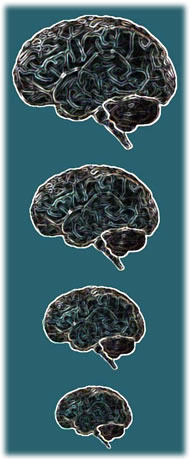 Humans have exceptionally large and complex brains. Two genes, microcephalin and ASPM, are suggested to have played a role in our cerebral evolution since mutation of either can lead to the severe clinical condition microcephaly (small brain). And studies carried out by researcher Bruce Lahn and his colleagues suggest that both genes might still be involved in the continuing evolution of human brains.
Humans have exceptionally large and complex brains. Two genes, microcephalin and ASPM, are suggested to have played a role in our cerebral evolution since mutation of either can lead to the severe clinical condition microcephaly (small brain). And studies carried out by researcher Bruce Lahn and his colleagues suggest that both genes might still be involved in the continuing evolution of human brains.
The exact DNA sequence of a gene can vary slightly from person to person due to the accumulation over time of harmless sequence changes, or mutations. This variation can be likened to the tuning of a radio station: small movements of the dial may or may not alter the quality of reception. Similarly, small DNA sequence differences (variants) may or may not alter the gene's functional ability. In terms of radio MHz variants it would be easy to tell if one of them improved the audible signal. In gene terms, however, it can be difficult to directly determine whether a particular sequence variant confers improvement. One good indicator is if the variant has become prevalent in the human population. This would strongly suggest that the evolutionary tuning dial has found a gene variant which gives those individuals carrying it some sort of survival or reproductive advantage. This is so called "positive selection". By sequencing approximately 90 human DNA samples from a panel of ethnically diverse individuals, the Lahn group found that for both the microcephalin and ASPM genes, one predominant variant exists.
To test whether, as suspected, the genes have undergone positive selection, the group calculated how likely it was that these gene variants had reached their present prevalence in the population just by chance. They found that, no matter which possible model of human demographic history they applied, given the high frequency of the variants, such a random emergence was extremely unlikely, confirming that positive selection had almost certainly taken place. Interestingly, positive selection in both genes has been relatively recent.
Divergence of anatomically modern humans is estimated to have occurred about 200,000 years ago. Using mutation rates as a kind of "molecular clock", the team determined that the prevalent microcephalin variant emerged approximately 37,000 years ago, while the prevalent ASPM variant appeared about 5,800 years ago. The group then went on to look at the global distribution of these positively-selected variants. By sequencing the versions of these genes carried by 1200 people from across the globe they found that the preferred microcephalin variant was common in all but sub-Saharan Africa, while the preferred ASPM variant was common only in Europeans and Middle-Easterners. The authors point out that emergence of the microcephalin variant coincides with archaeological estimates of the movement of humans into Europe and development of modern human behaviours, such as art and symbolism (approximately 40,000 years ago), while the emergence of the ASPM variant coincides with the development of written language and cities around 5000-6000 years ago. Such correlations, tidy as they may be, could lead to premature and potentially controversial speculation. It is therefore important to note that so far the group has no evidence as to the possible function under positive selection. Despite this the group has already patented the tests to determine whether an individual carries the preferential variants "we just thought we should patent the genes in case sometime in the future the tests become desirable commercially" says Bruce.
If Bruce's pet theory that the genes affect cognitive ability turns out to be true, these tests could raise serious social and ethical issues. But did Bruce himself test positive for the preferred variants? Perhaps wisely he has "decided to keep it a mystery for the time being". Both genes are known to regulate brain size and related studies suggest they might control cell proliferation (growth) in the developing brain. A related function such as motor control, cognition, brain size or susceptibility to neurological or psychiatric diseases is therefore possible but far from proven.
References
- Previous Cyanide Poisoning
- Next Hitchhikers guide to Science










Comments
Add a comment